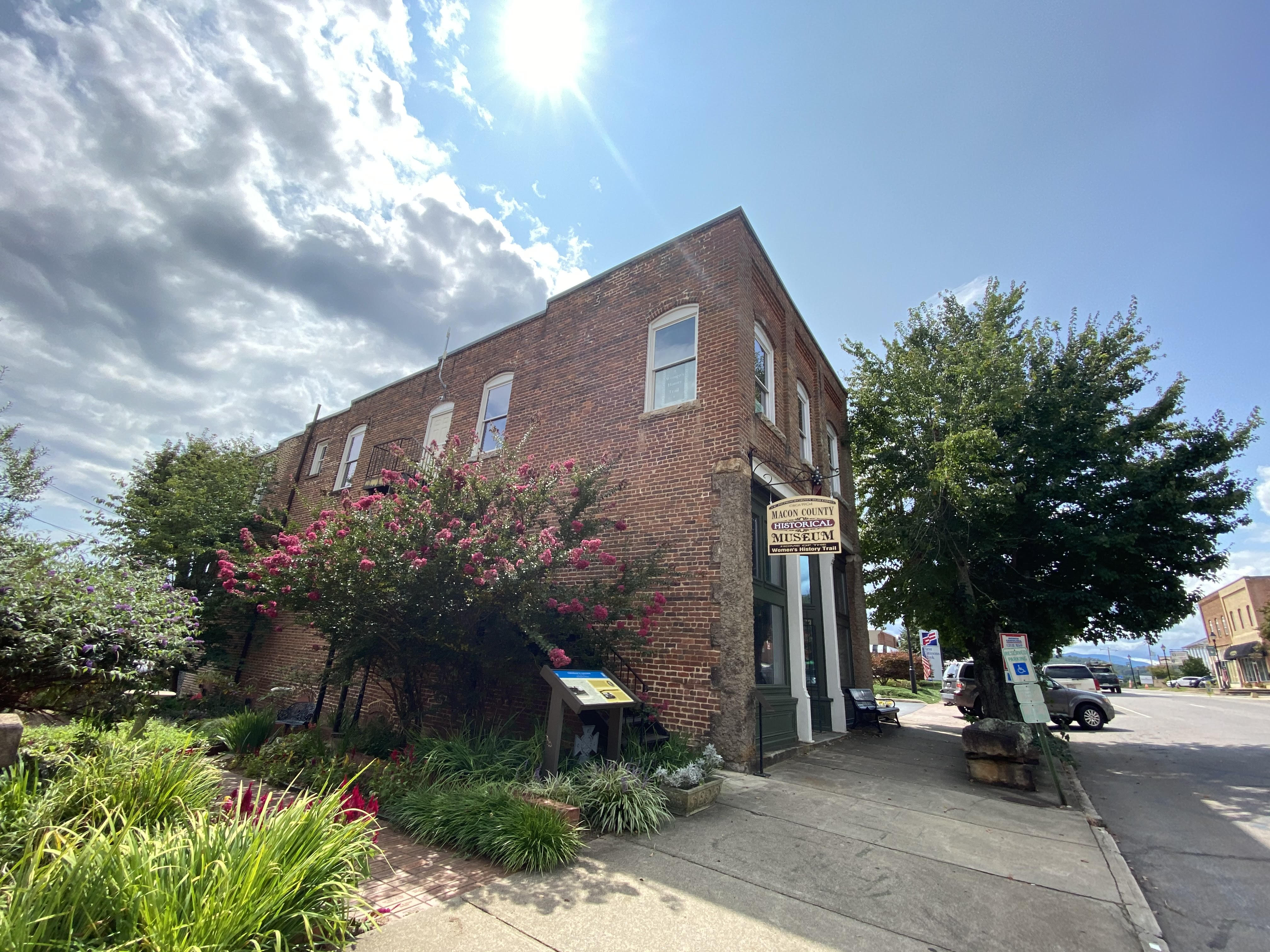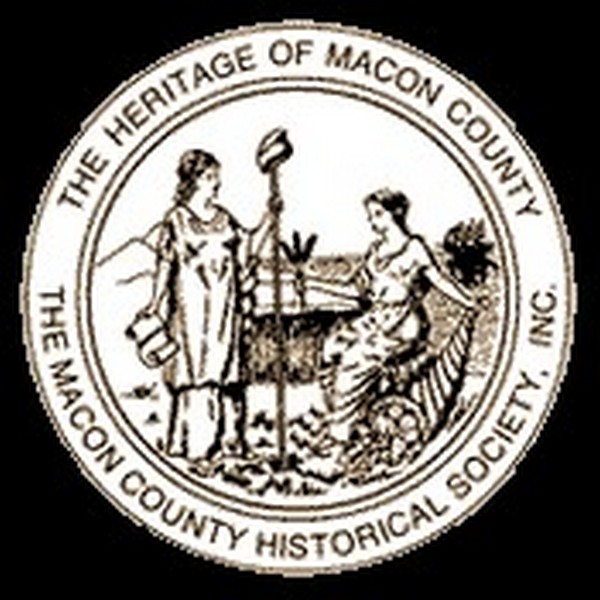Museum Collections
 The Macon County Historical Society was first formed in 1946 out of the concern and desire to preserve the Nikwasi Indian Mound. The Society successfully helped to raise funds to purchase the Nikwasi Mound, which was deeded to the Town of Franklin. Though inactive for a time after this initial objective was obtained, the Society was revived in 1976. By 1989, the Historical Society was able to secure the Pendergrass Building as its new home and they have remained there ever since.
The Macon County Historical Society was first formed in 1946 out of the concern and desire to preserve the Nikwasi Indian Mound. The Society successfully helped to raise funds to purchase the Nikwasi Mound, which was deeded to the Town of Franklin. Though inactive for a time after this initial objective was obtained, the Society was revived in 1976. By 1989, the Historical Society was able to secure the Pendergrass Building as its new home and they have remained there ever since.
At the turn of the century, Jesse R. Pendergrass, a Baptist Minister, school superintendent and local businessman, set out to erect the finest building in Macon County to house his dry goods store. J.R.’s ancestors settled in Macon County in the 1800s and helped to shape the county as we know it today. J.R. wanted to create something of quality, something that his family could call home and a place that folks across the South could stop in and sit a spell. Even in the early 1900s J.R. had the foresight to preserve history by salvaging wooden posts and floorboards from his original dry goods store to reuse in the construction of his new three story brick masterpiece.
For the last 30+ years, the Macon County Historical Society has called the old Pendergrass home. With a mission of preserving and celebrating every unique historical aspect of Macon County, it seems only fitting that the museum showcasing generations of treasures be housed in one of the most historical, well-kept buildings in Macon County.
The Pendergrass Building was built in 1904 and sold everything from clothing and hardware to school books for children, many of which can still be viewed today as they are now part of the Historical Museum’s collection.
Newspaper archives from 1903 begin to tell the story have the new three-story brick building and described the building as being “immediately considered the finest commercial building in Macon County.”
As a new building right off the center of town, the Franklin Press chronicled the construction process regularly reporting updates on the project.
The May 25, 1904 edition of The Franklin Press featured the headline “A New Brick Building Under Way” and reported that J.R. broke dirt on the project that week to make excavation for building a new brick storehouse on the site of his old wooden storeroom.
The June 29, 1904 Franklin Press reported that Mr. Shancks fired a kiln of 84,000 bricks to be used in the new store building. The original receipt for the purchase of those bricks is on display today at the Museum. A few days prior to the bricks being completed, J.F Ray, a local attorney, moved his law office to a room over E.H. Frank’s store so the original storehouse could be taken down and the new brick building erected.
“The brick work on Mr. Pendergrass’ store building is about completed and the studding for the rooms on the upper floor has all been placed,” reads an expert from the October 12, 1904 Franklin Press. “There will be seven office rooms and a hall on the upper floor with fire-places in the rooms and two large windows to nearly all the rooms. It will be the best business building in town when completed.”
By December 7, 1904 The Franklin Press reported “The lower room of Mr. J.R. Pendergrass’ new store building is practically finished, and he moved his stock of goods into it last Wednesday.”
By 1905, J.R.’s store became a community gathering place. The gigantic Maple that still stands in front of the building today was there 100 years ago. The tree is the last Maple standing on Main Street, but at one time the town was lined with the trees all the way up to Harrison Avenue. The trees provided covering for the dirt roads to keep them accessible to horses and wagons. Shade wasn’t the only thing the Maples provided; legend has it that politicians would hide bottles of liquor in the trees to pay off voters. Portraits dating back for generations feature the Maple playing host and providing shade for checker tournaments that were always spotted out front.
A 1950s account of a day in Franklin by Walter Hall describes a typical day in front of the building. “Outside the store there is a checker game in process, and a small group has gathered to challenge the winner. The ones I know are Ras Penland, Verlon McCoy, and Tillery Love.”
Checker matches in front the Pendergrass Building were such a staple for generations, that the Historical Museum still places a table and a board out front for anyone walking by.
Many original artifacts from the Pendergrass store can be viewed in the museum today. From J.R.’s hat, to school books, to original checks from The Bank of Franklin and even a handwritten receipt log detailing purchases from travelers stopping through. Some of the original advertisements and signs from the store can also be seen hung on the walls of the museum, as much of the building remains unchanged from when it served as a retail store, gathering place, and even a wedding venue with J.R. himself officiating the weddings.
J.R.’s son Brodie and his wife Dess took over the store in the 50s, and continued operating it until the store was closed in the late 1970s. Charles Sill and his son John purchased the building and restored it in 1976 and opened it as an art gallery called The Gum Gallery.
The Historical Society purchased the Pendergrass building in 1988 and opened it as the museum a year later. The building has since been added to The National Register of Historic Places and museum volunteers are constantly working to preserve the authenticity and history of the original structure. Some of the most noticeable original features of the building include the original plank floor, the distinctive woodwork, large twin counters made from yellow heart pine, the cast iron front and the suspended mezzanine.
The treasures on display at the Pendergrass building begin with the earliest accounts of settlement in the area – even before the land was acquired from the Cherokee Nation in the Treaty of 1819. Even more fascinating then the age of generations preserved within the museum is the ability to follow the evolution of the county and life of its residents. The walls of the Pendergrass buildings tells a story of progress and transition in Macon County follow the first schools, World Wars, electricity and automobiles to modern day history of notorious criminals such as Eric Rudolph to bouts of Hollywood Fame and making appearances on the Big Screen.
Today, the Pendergrass building is home to the richest depths of Macon County history dating back to a time long before the borders of the county were ever imagined and following along with historical markers that lead to the Macon County we all know and love today.
